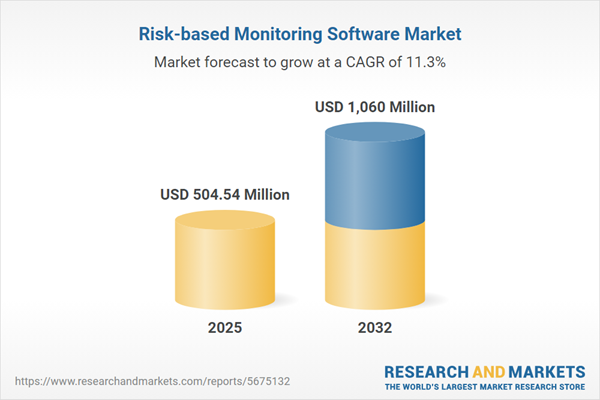Speak directly to the analyst to clarify any post sales queries you may have.
Risk-based monitoring software is rapidly becoming an essential part of modern clinical trial operations, driving improvements in efficiency, data quality, and regulatory compliance. Senior decision-makers must recognize the pivotal role of advanced monitoring technologies in safeguarding clinical outcomes and optimizing resource allocation across diverse research environments.
Market Snapshot: Risk-Based Monitoring Software Market Growth
The Risk-based Monitoring Software Market is expanding quickly, with revenues rising from USD 452.94 million in 2024 to USD 504.54 million in 2025. Projected to sustain an impressive 11.25% CAGR, the market value is positioned to reach USD 1.06 billion by 2032. This growth reflects increased adoption within pharmaceutical, biotechnology, medical device, and research organizations as they embrace digital platforms to manage evolving trial complexities and adhere to emerging global standards.
Scope & Segmentation of the Risk-Based Monitoring Software Market
- End Users: Academic and Research Institutes, Contract Research Organizations, Medical Device Manufacturers, Pharmaceutical and Biotech Companies
- Component: Analytics and Reporting, Key Risk Indicators, Risk Assessment, Visualization, Consulting, Implementation and Integration, Training and Support
- Deployment Type: Cloud, On Premise
- Application: Biotechnology, Medical Devices, Pharmaceuticals
- Study Type: Interventional Studies, Observational Studies
- Trial Phase: Phase I, Phase II, Phase III, Phase IV
- Organization Size: Large Enterprises, Small and Medium Enterprises
- Regional Coverage: Americas (including North America and Latin America), Europe, Middle East & Africa, Asia-Pacific
- Key Companies: Dassault Systèmes SE, Oracle Corporation, Veeva Systems, Inc., SAS Institute Inc., International Business Machines Corporation, Saama Technologies, Inc., CluePoints Ltd., BioClinica, Inc., Parexel International Corporation, Signant Health Ltd.
Key Takeaways for Decision-Makers
- Real-time analytics in risk-based monitoring software enable proactive identification of data anomalies and risk factors, reshaping oversight from reactive to continuous management.
- Artificial intelligence and machine learning integration empowers teams to detect subtle protocol deviations and strengthen trial safety measures.
- Global regulatory momentum and clear guidance drive the transition from manual site-centric monitoring to automated, auditable software platforms.
- Segment priorities differ: research institutions seek configuration flexibility; CROs focus on workflow consistency; medical device manufacturers require risk integration with device records; pharmaceutical firms prioritize harmonized program oversight.
- Decentralized and hybrid clinical trial models are fueling demand for cloud-based solutions, supporting remote monitoring, virtual visits, and streamlined compliance.
- Smaller organizations and startups are leveraging modular, customizable software for scalable growth without heavy upfront investments.
Tariff Impact on Clinical Trial Supply Chains and Operations
New United States tariffs effective in 2025 are increasing operational costs for organizations relying on hardware and cloud infrastructure linked to risk-based monitoring applications. These tariffs impact both software deployments and consulting engagements requiring cross-border collaboration. Decision-makers are actively exploring mitigation strategies, such as sourcing hardware from tariff-exempt markets, adopting regional cloud centers, and renegotiating service agreements to control costs and sustain trial momentum.
Risk-Based Monitoring Software Market: Methodology & Data Sources
This report adopts a multimethod research approach, combining primary interviews with clinical operations leaders and technology architects, systematic analysis of public and regulatory data, and quantitative scrutiny of anonymized deployment trends. A final validation phase involved direct stakeholder feedback to enhance accuracy and practical relevance.
Why This Report Matters to Senior Leaders
- Enables evidence-based decision-making by providing actionable insights on regulatory trends, vendor differentiation, and regional adoption patterns.
- Identifies strategic levers to optimize resource allocation and drive compliance with evolving monitoring guidelines.
- Equips stakeholders with segment-specific intelligence to support investment decisions, mitigate supply chain risks, and address the transition to decentralized trials.
Conclusion
The risk-based monitoring software market is transforming clinical trial practice, propelled by digital innovation and regulatory clarity. Leaders who leverage these insights can enhance operational agility and uphold clinical integrity, positioning their organizations for continued growth and compliance success.
Additional Product Information:
- Purchase of this report includes 1 year online access with quarterly updates.
- This report can be updated on request. Please contact our Customer Experience team using the Ask a Question widget on our website.
Table of Contents
3. Executive Summary
4. Market Overview
7. Cumulative Impact of Artificial Intelligence 2025
List of Figures
Samples

LOADING...
Companies Mentioned
The key companies profiled in this Risk-based Monitoring Software market report include:- Dassault Systèmes SE
- Oracle Corporation
- Veeva Systems, Inc.
- SAS Institute Inc.
- International Business Machines Corporation
- Saama Technologies, Inc.
- CluePoints Ltd.
- BioClinica, Inc.
- Parexel International Corporation
- Signant Health Ltd.
Table Information
| Report Attribute | Details |
|---|---|
| No. of Pages | 191 |
| Published | October 2025 |
| Forecast Period | 2025 - 2032 |
| Estimated Market Value ( USD | $ 504.54 Million |
| Forecasted Market Value ( USD | $ 1060 Million |
| Compound Annual Growth Rate | 11.2% |
| Regions Covered | Global |
| No. of Companies Mentioned | 11 |









